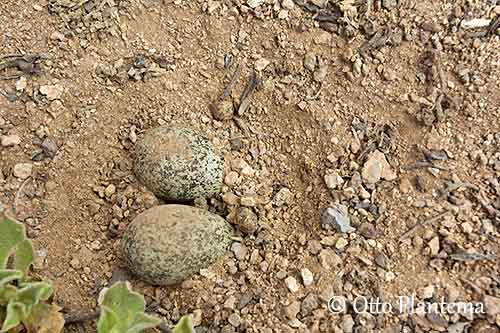
Fr: Gravelot de Sainte-Hélène
Ang: St. Helena Plover – Wirebird
All: St.-Helena-Regenpfeifer
Esp: Chorlitejo de Santa Elena
Ita: Corriere di Sant'Elena
Nd: Sint-Helenaplevier
Sd: Sankt Helenapipare
Photographer:
Otto Plantema
Trips around the world
Text by Nicole Bouglouan
Sources:
HANDBOOK OF THE BIRDS OF THE WORLD Vol 3 by Josep del Hoyo-Andrew Elliott-Jordi Sargatal - Lynx Edicions - ISBN : 8487334202
SHOREBIRDS by Peter Hayman, John Marchant and Tony Prater – Christopher Helm – 1986 – ISBN: 0747014035
BirdLife International (BirdLife International)
Saint Helena National Trust - The endemic Wirebird – Charadrius sanctaehelenae
Red List of Threatened species
Wikipedia, the free encyclopaedia
St. Helena Plover or Wirebird
Charadrius sanctaehelenae
Charadriiformes Order – Charadriidae Family
INTRODUCTION:
The St. Helena Plover is the only extant endemic bird species to Saint Helena Island. This species is mainly threatened by alteration of its preferred short-sward grassland habitat, due to lowered densities of cattle and sheep. Other habitats have been altered by invasive plant species. These factors involved declines in the early 1990s.
Introduced predators such rats, cats and Common Myna (Acridotheres tristis) often attack chicks and nests.
Human disturbances with off-road vehicles in semi-desert areas, and housing development encroaching on some breeding locations are increasing and affect the population of this species.
Several conservation actions are underway, in order to lead the population of the St. Helena Plover to larger and stable numbers, with no need of continuous conservation intervention.

DESCRIPTION OF THE BIRD:
Biometrics:
Length: 15 cm
The adult has dark brown upperparts with broad, pale buff edges to feathers.
The underparts are white and variably washed buff on flanks. The underwing shows brownish leading edge and primary coverts.
On the head, the top of the crown is brown with pale buff fringes. There is a black band on the forecrown and around the eyes, extending to the sides of head and neck. Just above, a white stripe encircles the brown crown.
The bill is black. The eyes are dark brown. The distinctive long, thin, wiry legs and the feet are black. The tarsus is about 38-41 mm. This feature has led to the other name of this bird: the “Wirebird”.
Both sexes are similar.

The juvenile is duller, without black markings on head and neck. The head pattern is dull brown and buffish. The lores are whitish. Crown and upperparts have narrow pale buff fringes. The underparts can be variably tinged pinkish-buff.
RANGE:
The St. Helena Plover is found on Saint Helena Island in South Atlantic Ocean.
HABITAT:
The St. Helena Plover frequents open upland habitats at middle elevation, and can be seen in dry, flat pastures and around the edges of the island. It favours the upland pastures recently grazed by cattle. It forages in ploughed fields and remote gardens. However, it never occurs on the shore. This species breeds on remote plains in N half of the island.
CALLS AND SONGS: SOUNDS BY XENO-CANTO
The St. Helena Plover gives short, soft “kee-vit” notes. The alarm call is mostly a rattling sound. A short trilling call can be given in flight.

BEHAVIOUR IN THE WILD:
The St. Helena Plover feeds mainly on ground-living insects such as beetles and caterpillars, usually caught by running, stop and grabbing the prey with the bill. It spends up to 60% of the day in foraging, and especially in the early morning and the late afternoon. But on bright moonlit nights, it may also feed after dark.
This species is often seen in pairs, and may form small groups of non-breeding birds.
The St. Helena Plover is known for its ability to defend the nest against predators. Once the predator is detected, the bird starts to run to lure the intruder away. Then, the adult performs the typical “broken wing display”, feigning and injury and drawing the predator away from the nest.

Nothing is known about the courtship displays, but we can suggest that the head pattern is enhanced by ritualized postures and movements.
The St. Helena Plover does not fly frequently like numerous island birds, and it is even reluctant to fly, but when in flight, the wings appear broad and rounded.
This species is sedentary and resident within its reduced range.
REPRODUCTION OF THIS SPECIES:
The breeding season occurs between late September and January, with peak in December/January, during the drier period of the year.
The St. Helena Plover nests on the ground, and withdraws to open plains in remote areas for breeding. The nest is a simple scrape lined with dry grass stems and rootlets.

The female usually lays 2 dark olive eggs with dark speckles. This colour makes the eggs almost invisible on the ground. When an incubating adult leaves the nest, it uses the lining to cover the eggs, making them very difficult to see.
Both mates incubate during about 4 weeks. The downy chicks often leave the nest within 36 hours of hatching, and follow their parents to the feeding areas. They usually fledge 5-6 weeks after hatching, but they often remain on their native territory for some time.
The chicks are killed by rats, cats and the Common Myna.

PROTECTION / THREATS / STATUS:
The St. Helena Plover is featured on St. Helena’s coat of arms, and the island residents held it in great affection.
Projects are underway by the RSPB and the St. Helena National Trust to manage the population of these birds, control the predators and try to stop the decline through conservation and restoration of the habitat.
The St. Helena Plover’s population was estimated at only 350 mature individuals in the most recent survey in 2011.
This species is currently classed as Critically Endangered.
